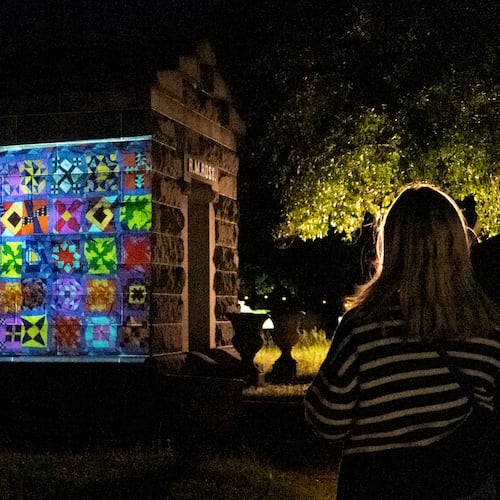This story was originally published by ArtsATL.
Dozens of the city’s most influential graffiti artists created new installations on the Atlanta Beltline from Nov. 3 to 5 as part of ATL Jam. The event celebrated Atlanta’s history and legacy of style writing and how it developed as part of hip-hop culture.
Hosted by Art on the Atlanta Beltline, the event took place at multiple locations along the trail simultaneously, with artists painting surfaces on the Southside and Westside trails. Artists whose work stretches back to the 1980s worked alongside younger artists. All revealed their unique take on the art of style writing, defined as the art of creating words using visual techniques that are generally unique to graffiti art.
The weekend’s featured style writers included The United Kings Crew — Atlanta’s first hip-hop graffiti crew — as well as Five Kings, Save, Totem and Dr. Dax.
Credit: Luke Gardner
Credit: Luke Gardner
Dr. Dax first saw graffiti when he moved to Atlanta in 1985.
“All graffiti existed off the MARTA line, and as quickly as they were showing up, they were disappearing,” he said. “I started paying attention, trying to figure out who was doing it. It has become a lifetime obsession.”
Back then, artists wrote their names in their unique style as a symbol of recognition among peers in the scene, never anticipating that the art form would explode into a global culture or be recognized years later with a public celebration.
Graffiti historian Antar “Cole” Fierce led a tour, explaining the legacy of style writing in Atlanta. He said the city’s earliest installations appeared around 1984 by the United Kings, the first graffiti crew in the city. They “created huge pieces off the highway and MARTA line,” he said.
The United Kings are considered an integral part of Atlanta’s first generation of graffiti artists, along with the Five Kings, but the two groups never met or overlapped in those early days, when style writers had to operate in secret because law enforcement and city officials were staunchly anti-graffiti.
“Now it’s the opposite,” Fierce said. “Now they look for and support this stuff and acknowledge it as art.”
Over the weekend, the Five Kings made an unannounced appearance, celebrating alongside the United Kings.
“Nobody has heard from Five Kings in 40 years,” Fierce said. “We’re so glad they all showed up. I don’t think they realized the value of their art. … They never thought it would last or mean anything, and here we are 50 years later.”
Credit: Luke Gardner
Credit: Luke Gardner
When hip-hop was forming in the late 1970s and early 1980s, break dancing, DJs, graffiti style writers — all of it was done on the street, Fierce said. “Artists became friends and were kindred spirits. They made their own art because they lacked access” to other spaces.
By the 1990s, the art had grown significantly, and painting in graffiti yards and underpasses had become commonplace. Artists from cities like New York and Los Angeles came to Atlanta, and styles started merging during a time Fierce refers to as the transplant era.
At the same time, Dax and other style writers hung out with artists and producers, leading to artistic collaborations with musicians like Outkast and producer Ray Murray of Organized Noize.
“This stuff is so intertwined,” Dax said. “Outkast put music on the map, and we put public art on the map.”
Years ago, artists created a space on an underpass in the Pittsburgh Yards neighborhood, right beneath the So So Def billboard that advertised Jermaine Dupri’s iconic hip-hop record label.
This underpass, where Fierce led the tour on Sunday, became known as a space where style writers would show their very best work. Still preserved on that underpass is an original style writing by the artist Save, who started in 1995 with fellow style writer Leon as part of the second wave of writing.
The weekend was vibrant proof that style writing now has a place in the city’s art landscape and the history of hip-hop culture.
::
Luke Gardner is an Atlanta-based journalist with a history of covering the arts. Luke is passionate about serving local communities and celebrating marginalized identities.
Credit: ArtsATL
Credit: ArtsATL
MEET OUR PARTNER
ArtsATL (www.artsatl.org), is a nonprofit organization that plays a critical role in educating and informing audiences about metro Atlanta’s arts and culture. Founded in 2009, ArtsATL’s goal is to help build a sustainable arts community contributing to the economic and cultural health of the city.If you have any questions about this partnership or others, please contact Senior Manager of Partnerships Nicole Williams at nicole.williams@ajc.com.
About the Author
Keep Reading
The Latest
Featured





